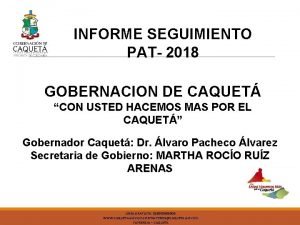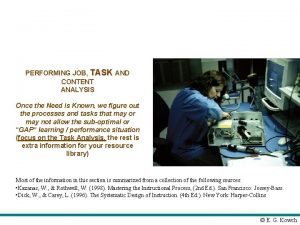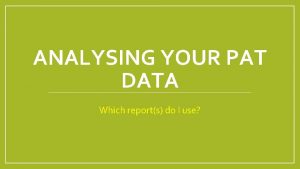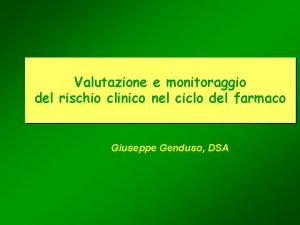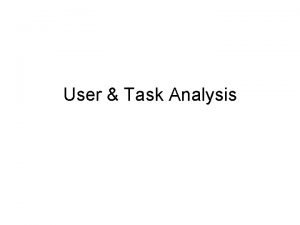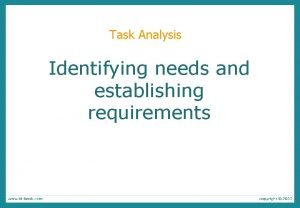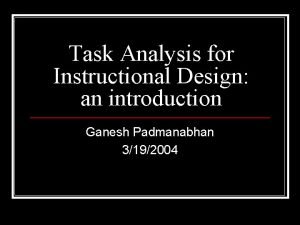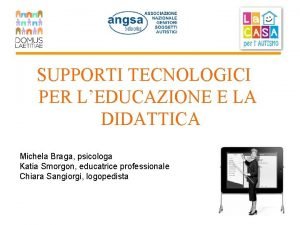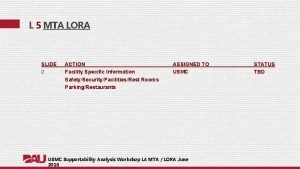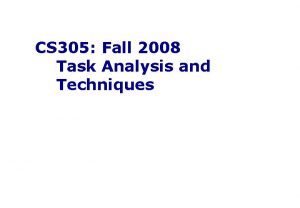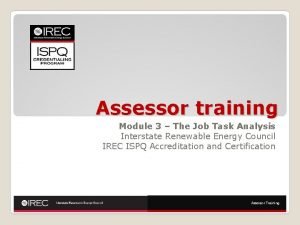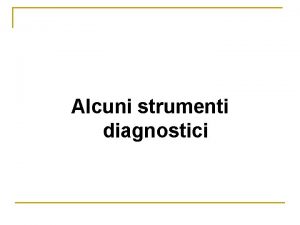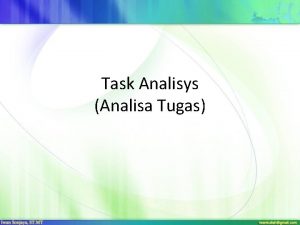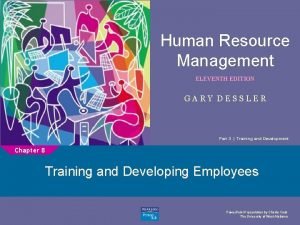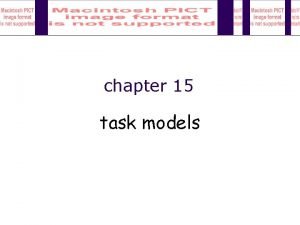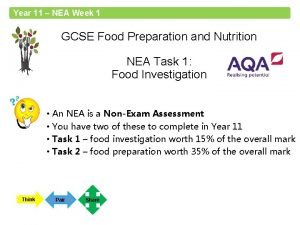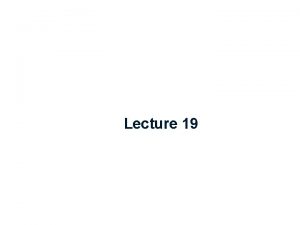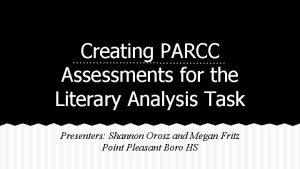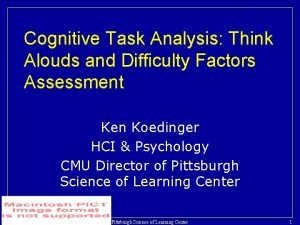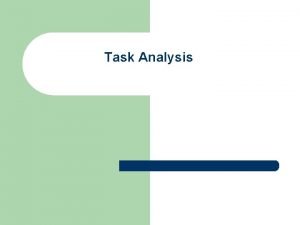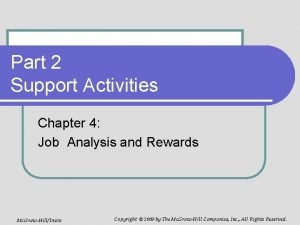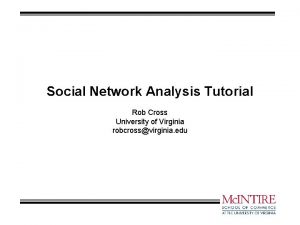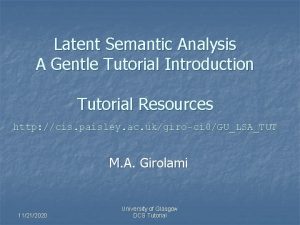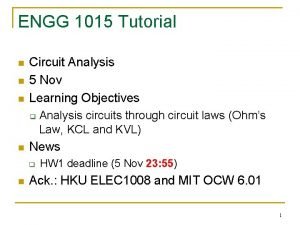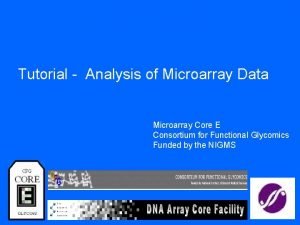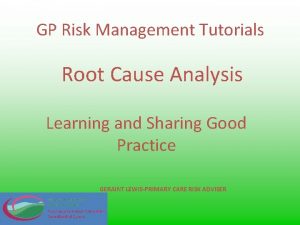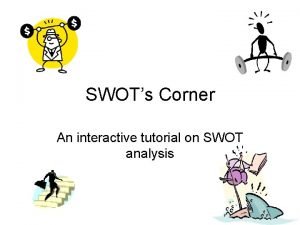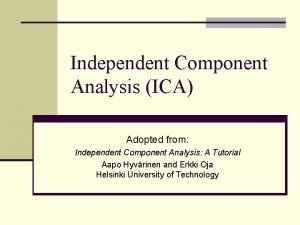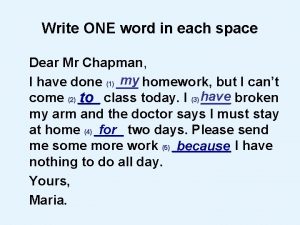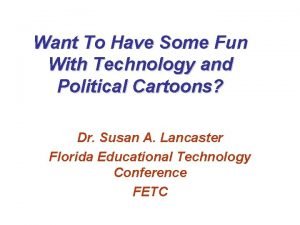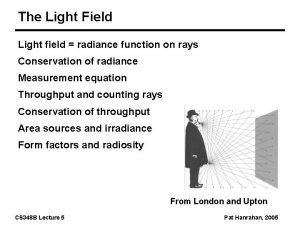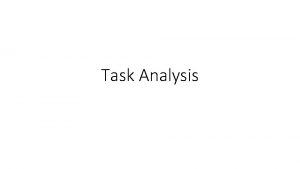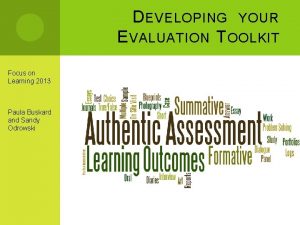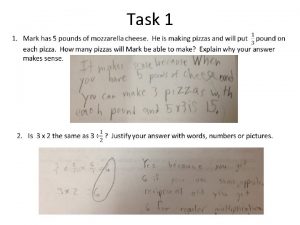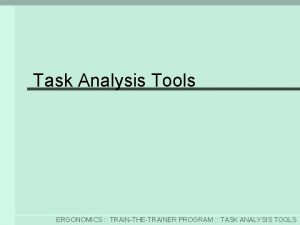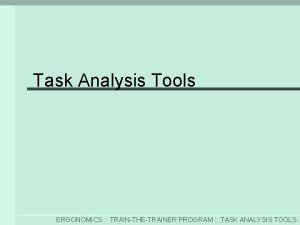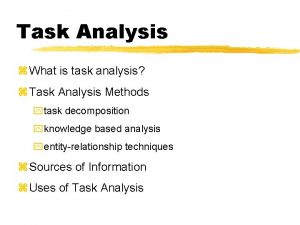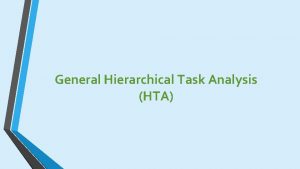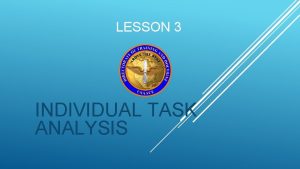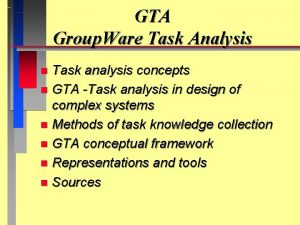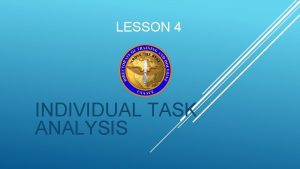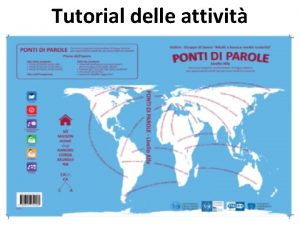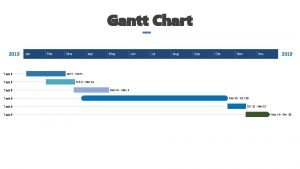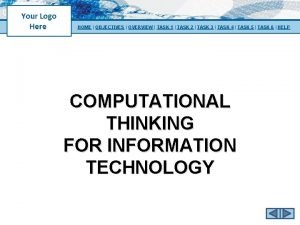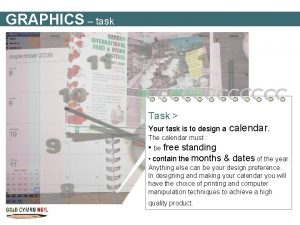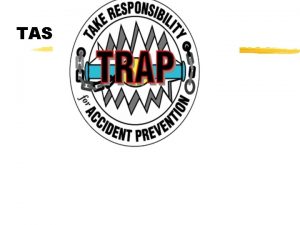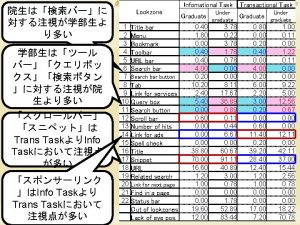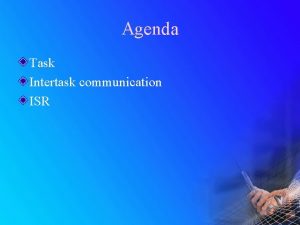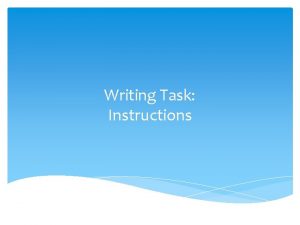Physics Analysis T oolkit PAT Tutorial PAT Task










































- Slides: 42

Physics Analysis T oolkit PAT Tutorial PAT Task Force contributors Wolfgang Adam, Volker Adler, Jeremy Andrea, Christian Autermann, Colin Bernet, Freya Blekman, Christophe Delaere, Gregory Hammad, Benedikt Hegner, Liz Sexton-Kennedy, Slava Krutelyov, Steven Lowette, Luca Lista, Gheorghe Lungu, Petar Maksimovic, Sudhir Malik, Petra Van Mulders Benedikt Mura, Giovanni Petrucciani, Charles Plager, Sal Rappoccio, Tanja Rommerskirchen, Frederic Ronga, Roberto Tenchini, Eric Vaandering, Jean-Roch Vlimant, Clemens Zeidler, you? ? Based on other similar tutorials 15 January 2009 JTERM III @LPC, Fermilab, 12 – 16, 2009

The Physics Analysis Tool. Kit Physics Analysis T oolkit Outline The CMS analysis environment Overview of Physics Analysis Toolkit (PAT) The Starter Kit Summary 15 January 2009 JTERM III @LPC, Fermilab, 12 – 16, 2009 2

The CMS Analysis Environment Physics Analysis T oolkit Outline The CMS analysis environment the CMS Event Data Model what the framework provides you with the different software components data access with CMSSW, FWLite and ROOT analysis within the CMS Computing Model the AOD event content Overview Physics Analysis Toolkit (PAT) The Starter Kit Summary 15 January 2009 JTERM III @LPC, Fermilab, 12 – 16, 2009 3

The CMS Analysis Environment Physics Analysis T oolkit The CMS Event Data Model the core of the CMS software is often referred to as “the framework” based upon the Event Data Model (EDM) the central concept is the “event” an event is immutable: existing information in the event cannot be changed exchange of information between modules happens only via the event is processed along a “path”, an ordered list of modules working with modules piece (or component) of CMSSW code that can be plugged into the CMSSW executable cms. Run EDProducer, EDFilter, EDAnalyzer, Output. Module (and EDLooper) modules to be arranged in sequences and to go into path https: //twiki. cern. ch/twiki/bin/view/CMS/Work. Book. CMSSWFramework 15 January 2009 JTERM III @LPC, Fermilab, 12 – 16, 2009 4

The CMS Analysis Environment Physics Analysis T oolkit What the Framework provides you with a binary, to which all modules are linked job configuration cms. Run config file language (python) + tools to read in job configurations into code avoids the need to recompile when parameters change Python tutorial http: //indico. cern. ch/conference. Display. py? conf. Id=37576 provenance tracking datafiles always contain a full history of the used configurations Event. Setup and services calibrations, logging, random numbers, . . . debugging and error handling reading in data PAT Layer-1 reading in files or streams retrieving data from the event producing and writing data creating 15 January 2009 your own objects and dataformats JTERM III @LPC, Fermilab, 12 – 16, 2009 5

The CMS Analysis Environment Physics Analysis T oolkit The different software components the main CMS software: CMSSW http: //cmssw. cvs. cern. ch/cgi-bin/cmssw. cgi/CMSSW/ contains everything from the core framework to analysis code also contains simulation, FWLite, Fireworks, Iguana daily workhorse: ROOT code compilation and external software configuration: SCRAM code management and reference: CVS, LXR, Doxygen http: //cmslxr. fnal. gov/lxr/source/ http: //cms-cpt-software. web. cern. ch/cms-cpt-software/General/gendoxy-doc. php job submission to the grid: CRAB data storage: ROOT, CORAL(COmbining Relations And Logic Language). . . 15 January 2009 JTERM III @LPC, Fermilab, 12 – 16, 2009 6

The CMS Analysis Environment Physics Analysis T oolkit Data access with CMSSW, FWLite and ROOT CMS event data is stored in ROOT files storing C++ classes into ROOT's TTrees happens through so called dictionaries ways of doing analysis on these ROOT files full framework, using cms. Run: full flexibility, but a bit cumbersome and a rather slow turn-around FWLite: access to the data formats and their methods in rootfiles, without the burden (and benefits) from the full framework; can be compiled in FW or ROOTor run interactively in ROOT sometimes both within the same analysis at different steps of complexity reduction 15 January 2009 JTERM III @LPC, Fermilab, 12 – 16, 2009 7

Physics Analysis T oolkit The CMS Analysis Environment Analysis within the CMS Computing Model event data is organized in so-called data-tiers RAW: output HLT; primary archive format; input to offline reconstruction RECO: offline reconstructed objects FEVT: RAW + RECO AOD: format for physics analysis; subset of RECO PAT: Physics Analysis Tools GEN: Monte-Carlo information SIM: simulated energy depositions (simhits) . . . https: //twiki. cern. ch/twiki/bin/view/CMS/Work. Book. Data. Formats 15 January 2009 JTERM III @LPC, Fermilab, 12 – 16, 2009 Event 8

The CMS Analysis Environment Physics Analysis T oolkit The AOD event content AOD is by definition a subset of RECO, and contains many small containers that are linked through associations very useful in computing: smaller than RECO very useful for development analysis within the CMS Computing Model logical consequence of the EDM “event” paradigm less problems of backwards incompatibility complicates an analyser's life significantly time-to-first-plot is too long; learning curve is too steep more on the AOD and RECO content https: //twiki. cern. ch/twiki/bin/view/CMS/SWGuide. Reco. Data. Format 15 January 2009 JTERM III @LPC, Fermilab, 12 – 16, 2009 9

Overview of the Physics Analysis Toolkit Physics Analysis T oolkit Outline The CMS analysis environment Overview of the Physics Analysis Toolkit PAT: what is it about? PAT: what it is not about the PAT in layers Output of PAT The Starter Kit Summary 15 January 2009 JTERM III @LPC, Fermilab, 12 – 16, 2009 10

Overview of the Physics Analysis Toolkit Physics Analysis T oolkit PAT: what is it about? bridge to close the gap between the rough AOD and physics plots common set of basic tools for almost any physics analysis in CMS we start from the needs from the physics user's perspective no code duplication and faster development with a common tool easier, faster and shared problem solving and debugging code reliability enhanced -> easier approvals of the results easy to switch from one to another analysis provide sensible defaults and configurations always have a consistent workflow through the PAT with very few includes allows to quickly bootstrap an analysis chain full FWLite compatibility PAT – Physics Tools in CVS http: //cmssw. cvs. cern. ch/cgi-bin/cmssw. cgi/CMSSW/Physics. Tools/ 15 January 2009 JTERM III @LPC, Fermilab, 12 – 16, 2009 11

Overview of the Physics Analysis Toolkit Physics Analysis T oolkit PAT: what it is not about we don't re-invent the wheel we don't rewrite the AOD objects, we stay in the Candidate model POG specific tasks remain with POGs, we provide an interface to POG's PAG specific algorithms remain within the PAG code-base (but we can provide infrastructure) the PAT is not a framework on it's own fully embedded in the EDM: no private “rootuples” are written profit from framework's persistency and provenance tracking we don't claim to cover all analysis use cases but 15 January 2009 if you need/have extra tools, let us know and contribute! JTERM III @LPC, Fermilab, 12 – 16, 2009 12

Overview of the Physics Analysis Toolkit Physics Analysis T oolkit The PAT in layers a multi-layered approach for maximal flexibility and user-friendliness within the constraints of the EDM event interpretation event hypothesis “Layer 0”: cleaning and disambiguation -> event interpretation + additional analysislevel tasks (e. g. MC+trigger matching) “Layer 1”: creation of big objects that collapse externally associated information -> no algorithmic tasks analysis “Layer 2”: event hypothesis dependent tasks -> provide possibility for re-tuning event interpretation “Starter Kit”: for data exploration and plotting “paste-your-analysis-here” https: //twiki. cern. ch/twiki/bin/view/CMS/SWGuide. PATLayer 0 https: //twiki. cern. ch/twiki/bin/view/CMS/SWGuide. PATLayer 1 15 January 2009 JTERM III @LPC, Fermilab, 12 – 16, 2009 13

Overview of the Physics Analysis Toolkit Physics Analysis T oolkit Output of PAT The input of the PAT is AOD/RECO. The output of the PAT is your business We give tools for many output options: Skimming – dropping events Slimming – dropping candidates – taus, electrons… Thinning – making object smaller i. e. dropping info We do not constrain any of them. It is entirely between you, your PAG/POG, and the other members of your analysis This is not intended to be another large scale layer of production but it is becoming one 15 January 2009 JTERM III @LPC, Fermilab, 12 – 16, 2009 14

The Starter Kit Physics Analysis T oolkit Outline The CMS analysis environment Overview Physics Analysis Toolkit (PAT) The Starter Kit Goals Components Overview The Starter Kit in practice Summary 15 January 2009 JTERM III @LPC, Fermilab, 12 – 16, 2009 15

The Starter Kit Physics Analysis T oolkit Goals a plotting package for standard plots of standard objects the CMS Event Data Model allows quick exploration of data without lots of coding and bookkeeping goal is to provide several analysis examples, monitored for physics changes make histograms and simple “rootuples” out of PAT Layer-1 or Layer-2 objects user can easily add plots (requiring some coding, obviously) the Starter Kit is ideal to make you step into CMS analysis and get to do some physics https: //twiki. cern. ch/twiki/bin/view/CMS/Work. Book. Analysis. Starter. Kit 15 January 2009 JTERM III @LPC, Fermilab, 12 – 16, 2009 16

The Starter Kit Physics Analysis T oolkit Components Pat. Analyzer. Skeleton “Very. Simple. Pat. Analysis” plugin Shows how to pull out PAT objects and loop over them simply Pat. Analyzer. Kit “Starter. Kit” plugin Plots everything in the event and has a simple ntuple interface Composite. Kit 15 January 2009 Plots an input collection of composite candidates JTERM III @LPC, Fermilab, 12 – 16, 2009 17

The Starter Kit Physics Analysis T oolkit The Starter Kit in practice (it’s a package NOT a module) examples in the CMS Workbook what it does for you automatically plot four vector and object ID variables for all objects in the event sensible default axis limits also simple rootuples of these variables can be added driven by configuration files check it out in the tutorial! 15 January 2009 JTERM III @LPC, Fermilab, 12 – 16, 2009 18

The Starter Kit 15 January 2009 JTERM III @LPC, Fermilab, 12 – 16, 2009 Physics Analysis T oolkit 19

The Starter Kit Physics Analysis T oolkit Outline The CMS analysis environment Overview of Physics Analysis Toolkit (PAT) Summary 15 January 2009 Conclusions Documentation Tutorial JTERM III @LPC, Fermilab, 12 – 16, 2009 20

Conclusions Physics Analysis T oolkit the PAT is a vital project started from and unifies the several CMS analysis frameworks emphasis on both flexibility and user-friendliness core PAT functionality is in good shape the PAT is ready for users out-of-the-box examples available documentation coming into place embedded successfully in Layer-2 and Starter Kit users/testers from all PAGs coming in first analysis results being produced with PAT there is still a to-do list of course we keep a prioritized list linked to the twiki users are encouraged to contribute! -> not all tasks have names assigned -> add your own tools for existing/missing features! 15 January 2009 JTERM III @LPC, Fermilab, 12 – 16, 2009 21

Documentation Physics Analysis T oolkit Documentation and support ( get used to twikis and book mark them) documentation currently PAT's highest priority! with help from the CMS documentation people (Kati et al. ) central wiki page in the CMS Software Guide: https: //twiki. cern. ch/twiki/bin/view/CMS/SWGuide. PAT and many links therein Starter Kit workbook to get you started https: //twiki. cern. ch/twiki/bin/view/CMS/Work. Book. Analysis. Starter. Kit PAT page in the CMS workbook: contains the PAT tutorial https: //twiki. cern. ch/twiki/bin/view/CMS/Work. Book. PAT see also the more general Physics Tools page: https: //twiki. cern. ch/twiki/bin/view/CMS/SWGuide. Physics. Tools FWLite https: //twiki. cern. ch/twiki/bin/view/CMS/SWGuide. FWLite. Analysis Fireworks https: //twiki. cern. ch/twiki/bin/view/CMS/Work. Book. Fireworks For submitting jobs on grid please go through CRAB pre-tutorial https: //twiki. cern. ch/twiki/bin/view/Main/Eric. Vaandering. CRABPre. Tutorial. JTerm all questions about PAT should currently go to the Physics. Tools hypernews Look for data in DBS https: //cmsweb. cern. ch/dbs_discovery/ https: //twiki. cern. ch/twiki/bin/view/CMS/Work. Book. Data. Samples Write your own analyser https: //twiki. cern. ch/twiki/bin/view/CMS/Work. Book. Write. Framework. Module support 15 January 2009 hn-cms-phys. Tools@cern. ch JTERM III @LPC, Fermilab, 12 – 16, 2009 22

Tutorial Physics Analysis T oolkit There will now be a step-by-step tutorial session to put this into practice! Starter Kit tutorial https: //twiki. cern. ch/twiki/bin/view/CMS/Work. Book. Analysis. Starter. Kit. Code. Descrip tion https: //twiki. cern. ch/twiki/bin/view/CMS/Work. Book. PAT Also try to attend the following two talks tomorrow for more general overview/status 9: 00 CMS Software - Elizabeth Sexton-Kennedy (Fermilab) 9: 25 Physics Tools and Analysis Model – Salvatore Rappoccio (Johns Hopkins) 15 January 2009 JTERM III @LPC, Fermilab, 12 – 16, 2009 23

Tutorial Please login to your cmslpc account Open the first twiki and we will go through it step by step Physics Analysis T oolkit https: //twiki. cern. ch/twiki/bin/view/CMS/Work. Book. Analysis. Sta rter. Kit On the twiki all the text in blue boxes is coding All the command lines and output is in brown boxes Further questions malik@fnal. gov 15 January 2009 JTERM III @LPC, Fermilab, 12 – 16, 2009 24

Backup Slides 15 January 2009 JTERM III @LPC, Fermilab, 12 – 16, 2009 Physics Analysis T oolkit 25

Overview of the PAT Physics Analysis T oolkit Quote from the PAT mandate 15 January 2009 JTERM III @LPC, Fermilab, 12 – 16, 2009 26

PAT Layer-0 Physics Analysis T oolkit Design considerations remember we want to reconcile maximal flexibility vs. maximal ease-of-use every action in the following steps is required to be fully configurable from config files so also switched on/off every algorithm in the following steps needs to be factorized from the CMSSW framework, such that it can be re-used within FWLite this means that e. g. no interface to the algorithms should involve the configuration language, and no database access is required 15 January 2009 JTERM III @LPC, Fermilab, 12 – 16, 2009 27

PAT Layer-0 Physics Analysis T oolkit Object-dependent ID and cleaning object identification (ID) variables produce if not on AOD yet using POG recommendations as defaults interface multiple algorithms provide possibility for custom ID object flagging and cleaning technically: a cleaner (EDProducer) calls a FW-independent selector -> this factorizes algorithmic code from the rest use the ID variables to choose “clean objects” technical implementation with flags written in the 'status' of the object -> also used in the next step of event-wide ambiguity resolution possibility to keep “clean”, “non-clean” and all objects -> e. g. isolated vs. non-isolated electrons 15 January 2009 JTERM III @LPC, Fermilab, 12 – 16, 2009 28

PAT Layer-0 Physics Analysis T oolkit Cross-object ambiguity resolution happens logically in the same processing steps as the Layer-0 cleaners both “clean”, “not-clean” and “all” collections can be used to check overlaps in photon cleaning in tau cleaning current default: only electrons (but in addition e. g. taus can be used) sequence of cleaners determines the order of ambiguity resolving functionality there, but all switched off by default in jet cleaning electron removal “by. Seed” (default) or “by. Super. Cluster” default order: muons, electrons, photons, taus, jets once cleaning disambiguation is done MET can be easily recomputed 15 January 2009 JTERM III @LPC, Fermilab, 12 – 16, 2009 29

PAT Layer-0 Physics Analysis T oolkit Production of additional associated information at the end of the Layer-0 processing, additional analysis-level tasks can be performed to produce information not present yet in the RECO/AOD this should involve all remaining tasks depending on the framework leave no obstacles to use FWLite on Layer-0 output some of these tasks don't involve an event interpretation (can possibly run before the actual Layer-0) retrieval jet energy scale factors parton flavour determination for jets jet-track association and jet charge additional b- and tau-tagging . . . some tasks depend on the event interpretation MC matching, trigger primitive matching external MET recalculation? . . . 15 January 2009 JTERM III @LPC, Fermilab, 12 – 16, 2009 30

PAT Layer-1 Physics Analysis T oolkit PAT objects: enriched reco dataformats PAT Layer-1 brings lots of related information together in “big” objects easy one-entry user interface to previously associated information 1 -object approach without remaining associations makes it easy for users to play with the objects: event selection, scaling and smearing, vetoing, kinematic transformations, event hypothesis building, etc. PAT Layer-1 objects implemented: Electron, Muon, Tau, Jet, Photon, MET inherit from reco dataformats additional members and methods for accessing the extra information only store what is asked for by the user will provide a uniform interface to Particle Flow objects 15 January 2009 JTERM III @LPC, Fermilab, 12 – 16, 2009 31

PAT Layer-1 Physics Analysis T oolkit PAT object interfaces all PAT objects have methods to access their MC and trigger matches have methods to retrieve resolutions obtained from MC pat: : Photon, pat: : Electron, pat: : Muon and pat: : Tau contain pat: : Jet methods to access isolation and ID variables provides access to b-tagging information methods for handling jet corrections access to jet flavour from MC interface to associated tracks and jet charge pat: : MET MC 15 January 2009 match is in this case the generated MET JTERM III @LPC, Fermilab, 12 – 16, 2009 32

PAT Layer-2 Physics Analysis T oolkit Introducing event hypotheses up to now no assumptions have been made about the final state in principle the final state hypothesis belongs more to the analysis but tools and examples can be provided to users on how to easily deal. Z with -> their muon specific + muonfinal state User has a “physics process” in mind: Want to support Can 15 January 2009 muon 1 : muon 2 : muon structures that mimic Z = muon 1 + muon 2 this intuitive picture H -> (Z -> muon + muon) + (Z -> electron + electron) muon 1 : layers muon of hypothesis support multiple muon 2 : muon electron 1 : electron 2 : electron Z 1 = muon 1 + muon 2 Z 2 = electron 1 + electron 2 H = Z 1 +IIIZ 2 JTERM @LPC, Fermilab, 12 – 16, 2009 33

PAT Layer-2 Physics Analysis T oolkit Flat event hypothesis Provided by a simple list that associates strings to objects Access data members through those strings Supports PERL-syntax regexpr Hierarchical event hypothesis Cand. Looper looper<Muon> = hyp. loop("muon. "); while( !looper() ) { const Muon & mu = *looper; fill( mu. pt() ); looper++; } Uses a “named” Composite Candidate to store decay structures in a hierarchy Access data members through Candidate linked list utilities Added functionality: can access daughters by role string instead of index const Candidate * Z 1 = H. daughter("Z 1"); 15 January 2009 JTERM III @LPC, Fermilab, 12 – 16, 2009 34

PAT Layer-2 Physics Analysis T oolkit “Hard coded” event hypotheses • Top Quark Analysis Framework (TQAF) Has hard coded ttbar hypothesis pat: : Jet get. Hadb() const; pat: : Jet get. Hadp() const; pat: : Jet get. Hadq() const; pat: : Jet get. Lepb() const; pat: : Muon get. Muon() const { return *muon_; }; pat: : Electron get. Electron() const { return *electron_; }; pat: : MET get. Neutrino() const { return *neutrino_; }; Recently have interfaced Tt. Semi. Evt. Solution with Named. Composite. Candidates to provide generic access as a prototype const reco: : Named. Composite. Candidate & get. Reco. Hyp() const { return reco. Hyp_; } Others are out there 15 January 2009 JTERM III @LPC, Fermilab, 12 – 16, 2009 35

? ? Ignore warning during scramv 1 b Version – data compatibility Ask questions at hn-cms-phys. Tools@cern. ch How to get files of the web (wget) Look for data in DBS https: //twiki. cern. ch/twiki/bin/view/CMS/Work. Book. Write. Frame work. Module For advance tutorial, go through CRAB pre-tutorial 15 January 2009 https: //cmsweb. cern. ch/dbs_discovery/ Write your own analyser Physics Analysis T oolkit https: //twiki. cern. ch/twiki/bin/view/Main/Eric. Vaandering. CRABP re. Tutorial. JTerm JTERM III @LPC, Fermilab, 12 – 16, 2009 36

Overview of the Candidate Model Physics Analysis T oolkit What is a Candidate? • Represented by a vertex and a four-vector Has particle ID information Anything that has a four-vector and a vertex inherits from Candidate Jets Electrons Photons Muons Missing Et Candidates can have detector objects as data members Support for lists of candidates Can also have composite candidates 15 January 2009 JTERM III @LPC, Fermilab, 12 – 16, 2009 37

Overview of the Candidate Model Physics Analysis T oolkit Navigation • Candidates have “mothers” and “daughters” For instance, Monte Carlo particles are Candidates (Gen. Particle), have access to full linked list of ancestry and progeny const Gen. Particle & higgs = get. Higgs. From. Somewhere(); for( size_t i = 0; i < higgs. number. Of. Daughters(); ++ i ) { const Candidate * Z = higgs. daughter( i ); } Composite candidates “act” exactly the same way! In above example, replace Gen. Particle with Composite. Candidate, and you’re =done! const Composite. Candidate & higgs get. Reconstructed. Higgs(); for( size_t i = 0; i < higgs. number. Of. Daughters(); ++ i ) { const Candidate * Z = higgs. daughter( i ); } 15 January 2009 JTERM III @LPC, Fermilab, 12 – 16, 2009 38

Physics Analysis T oolkit Overview of the Candidate Model Hierarchical structure • t Access hypotheses in an intuitive way Easy interface for I/O of your objects b W Can have shallow clones for storing kinematics of fitted objects Utilize common plotting utilities to save you time Ultimately a time saver! • 15 January 2009 JTERM III @LPC, Fermilab, 12 – 16, 2009 39

Overview of the Candidate Model • Physics Analysis T oolkit Changes to candidate types Previously Candidate landscape was a little cluttered We changed that! (>=2. 0. 9, >=2. 1. 0 pre 6) The only things you need to worry about are “by value”: Candidate (base Candidates) “by pointer”: Ptr<Candidate> (smart pointers to Candidates) “by shallow clone pointer”: Shallow. Clone. Ptr. Candidate (Ptr<Candidate> which has different four-vector and vertex, suitable for fitting, etc) Composite Candidates have also subsumed functionality of “Named. Composite. Candidates” Can now add names and roles to Composite. Candidate, Named. Composite. Candidate is deprecated 15 January 2009 JTERM III @LPC, Fermilab, 12 – 16, 2009 40

Overview of the Candidate Model Physics Analysis T oolkit Candidate Selectors • Many selectors overall Mostly limited to things available to candidate Can use the same functionality to make more advanced selectors • Pt, eta, delta R, pdg id, etc This is a little cumbersome to do Where’s the code? Some examples: http: //cmslxr. fnal. gov/lxr/source/Physics. Tools/Cand. Selectors/plugins/ http: //cmslxr. fnal. gov/lxr/source/Physics. Tools/Reco. Algos/plugins/ The real drivers: http: //cmslxr. fnal. gov/lxr/source/Physics. Tools/Util. Algos/interface/Sing le. Object. Selector. h http: //cmslxr. fnal. gov/lxr/source/Physics. Tools/Util. Algos/interface/Obj ect. Selector. h module good. Muons = Cand. Selector { Input. Tag src = all. Muons string cut = "pt > 5. 0" } 15 January 2009 JTERM III @LPC, Fermilab, 12 – 16, 2009 41

Overview of the Candidate Model • Candidate Combiners Cand. View. Combiner Combines by “value” Outputs View<Composite. Candidate> with value clones of leaves Cand. View. Shallow. Clone. Ptr. Combiner • Physics Analysis T oolkit Combines by “shallow clone pointer” Outputs View<Composite. Candidate> with shallow clones of leaves Where’s the code? Physics. Tools/Cand. Algos/interface/Cand. Combiner. h Physics. Tools/Cand. Utils/interface/Cand. Combiner. Base. h plugin definition Workhorse for the actual combinations Physics. Tools/Cand. Utils/interface/Cand. Combiner. h 15 January 2009 Driver for workhorse module z. To. Mu = Cand. View. Shallow. Clone. Combiner { string decay = "muons@+ muons@-" string cut = "50 < mass < 120” string name = “z. To. Mu” vstring roles = {‘mu 1’, ‘mu 2’} } JTERM III @LPC, Fermilab, 12 – 16, 2009 42
 Pat pat seguimiento
Pat pat seguimiento Job content analysis
Job content analysis Tiered task bias task
Tiered task bias task Pat achievement bands
Pat achievement bands Same song poem
Same song poem Modern physics vs classical physics
Modern physics vs classical physics University physics with modern physics fifteenth edition
University physics with modern physics fifteenth edition Physics ia rubric
Physics ia rubric Esempio di task analysis
Esempio di task analysis User task
User task Rapid toilet training protocol
Rapid toilet training protocol Hierarchical task analysis
Hierarchical task analysis Task analysis instructional design
Task analysis instructional design Esempio di task analysis scuola primaria
Esempio di task analysis scuola primaria Maintenance task analysis
Maintenance task analysis Task analysis example
Task analysis example Task analysis definition
Task analysis definition Vmi test età
Vmi test età Contoh hta
Contoh hta Task analysis record form
Task analysis record form Cognitive task analysis definition
Cognitive task analysis definition Task analysis shaving
Task analysis shaving Nea 1 food preparation and nutrition example
Nea 1 food preparation and nutrition example Task analysis in hrd
Task analysis in hrd Red cranes by jacey choy
Red cranes by jacey choy Cognitive task analysis in the classroom
Cognitive task analysis in the classroom Task analysis questions
Task analysis questions Ib social skills
Ib social skills Task dimensions job analysis
Task dimensions job analysis Task analysis in hci
Task analysis in hci Social network analysis tutorial
Social network analysis tutorial Latent semantic indexing tutorial
Latent semantic indexing tutorial Nnn tutorial
Nnn tutorial Alice 3 tutorial
Alice 3 tutorial Microarray data analysis tutorial
Microarray data analysis tutorial Root cause analysis tutorial
Root cause analysis tutorial Interactive swot analysis
Interactive swot analysis Independent component analysis tutorial
Independent component analysis tutorial Dear pat i arrived
Dear pat i arrived Pat oliphant cartoon archive
Pat oliphant cartoon archive Examples of phonemes
Examples of phonemes Pat coso
Pat coso The princess pat lyrics
The princess pat lyrics
